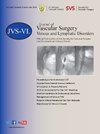揭示静脉溃疡中疼痛与细菌负荷量之间的关系及其对针对性治疗的影响
IF 2.8
2区 医学
Q2 PERIPHERAL VASCULAR DISEASE
Journal of vascular surgery. Venous and lymphatic disorders
Pub Date : 2025-02-19
DOI:10.1016/j.jvsv.2025.102213
引用次数: 0
摘要
目的:细菌与静脉溃疡疼痛之间的关系已经确立,并主要归因于炎症途径。荧光成像在床边实时检测临床重要的细菌负荷和生物膜,以客观的方式通知其消除。我们试图探索细菌荧光信号和患者报告的静脉溃疡疼痛的区域共定位,如果客观地靶向细菌去除可以减少伤口相关的疼痛。方法:我们评估了46名下肢静脉溃疡患者,他们自报伤口相关疼痛评分≥4分(1-10分)。在进行任何治疗之前(例如,清创),患者在研究访问期间评估他们的疼痛,并捕获荧光图像。疼痛区域和阳性荧光信号被勾画到打印的伤口图像上。术后重复荧光成像,患者在研究访问结束时或第二天通过电话重新评估他们的疼痛。半定量分析包括对伤口床上荧光区域和疼痛区域重叠百分比的视觉估计。Wilcoxon配对对签名秩检验和Mann-Whitney t检验评估手术后疼痛评分的变化。结果:细菌负荷和生物膜升高引起的荧光在每个评估的静脉溃疡中都存在,通常覆盖高达50%的伤口床,并且通常定植在伤口边缘。伤口床内疼痛区比荧光区更广泛,46例患者中有40例(87%)发现了一定程度的重叠。这种重叠通常很大(29例>重叠25%,16例>重叠50%)。总体平均疼痛评分术前为8.17分,术后为6.87分,减少了1.30分,具有高度统计学意义(p结论:我们观察到临床上显著的细菌定植和生物膜的荧光信号在下肢静脉性溃疡中普遍存在。患者报告的疼痛区域和阳性荧光经常重叠,表明两者之间存在关系。通过实时荧光成像进行客观目标细菌去除后,伤口相关疼痛评分显着立即降低,第二天观察到更大的降低。了解慢性细菌存在与静脉溃疡疼痛之间的关系可以为治疗和管理策略提供信息,潜在地提高患者的生活质量和满意度,促进愈合,减少并发症。本文章由计算机程序翻译,如有差异,请以英文原文为准。
Unveiling the relationship between pain and bacterial load in venous ulcers with implications in targeted treatment
Objective
The relationship between bacteria and venous ulceration pain is well-established and primarily attributable to inflammatory pathways. Fluorescence imaging detects clinically significant bacterial loads and biofilm in real time at the bedside, informing its elimination in an objective manner. We sought to explore the regional co-localization of bacterial fluorescence signals and patient-reported venous ulceration pain, and if objectively targeted bacterial removal can reduce wound-associated pain.
Methods
We evaluated 46 adults with venous ulceration of the lower extremity self-reporting a wound-associated pain score of ≥4 on a scale of 1 to 10. Before any treatments were performed (eg, debridement), patients rated their pain during the study visit, and fluorescence images were captured. Regions of pain and positive fluorescence signals were sketched onto a printed wound image. Fluorescence imaging was repeated post procedurally, and patients rerated their pain either at the end of the study visit or over the phone the following day. Semiquantitative analysis involved visual estimation of the percentage overlap between regions of fluorescence and pain in the wound bed. Wilcoxon matched pairs signed rank tests and Mann-Whitney t tests assessed changes in pain scores post procedurally.
Results
Fluorescence from elevated bacterial loads and biofilm was present in every venous ulcer assessed, usually covering ≤50% of the wound bed and commonly colonizing the wound edges. Regions of pain were more extensive than regions of fluorescence within the wound bed, and some degree of overlap was identified in 40 of 46 patients (87%). This overlap was often substantial (29 patients with >25% overlap and 16 with >50% overlap). Overall mean pain scores were 8.17 before the procedure and 6.87 after the procedure, corresponding with a 1.30-point reduction that was highly statistically significant (P < .0001). Pain score reduction was higher when patients rerated their pain 1 day after debridement (3.40-point reduction; P = .004).
Conclusions
We observed that fluorescence signals from clinically significant bacterial colonization and biofilms were commonly present in painful venous lower extremity ulcerations. Regions of patient-reported pain and positive fluorescence frequently overlapped, suggesting a relationship between the two. Wound-associated pain scores were significantly and immediately reduced after objectively targeted bacterial removal via real-time fluorescence imaging, with an even greater reduction observed by the next day. Understanding the association between chronic bacterial presence and pain in venous ulcers can inform treatment and management strategies, potentially enhancing patient quality of life and satisfaction, promoting healing, and reducing complications.
求助全文
通过发布文献求助,成功后即可免费获取论文全文。
去求助
来源期刊

Journal of vascular surgery. Venous and lymphatic disorders
SURGERYPERIPHERAL VASCULAR DISEASE&n-PERIPHERAL VASCULAR DISEASE
CiteScore
6.30
自引率
18.80%
发文量
328
审稿时长
71 days
期刊介绍:
Journal of Vascular Surgery: Venous and Lymphatic Disorders is one of a series of specialist journals launched by the Journal of Vascular Surgery. It aims to be the premier international Journal of medical, endovascular and surgical management of venous and lymphatic disorders. It publishes high quality clinical, research, case reports, techniques, and practice manuscripts related to all aspects of venous and lymphatic disorders, including malformations and wound care, with an emphasis on the practicing clinician. The journal seeks to provide novel and timely information to vascular surgeons, interventionalists, phlebologists, wound care specialists, and allied health professionals who treat patients presenting with vascular and lymphatic disorders. As the official publication of The Society for Vascular Surgery and the American Venous Forum, the Journal will publish, after peer review, selected papers presented at the annual meeting of these organizations and affiliated vascular societies, as well as original articles from members and non-members.
 求助内容:
求助内容: 应助结果提醒方式:
应助结果提醒方式:


